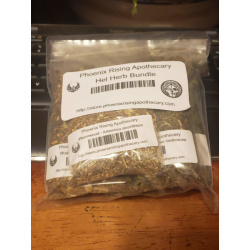Search
Search Criteria
Products meeting the search criteria
This tall, showy herb of the compositae family never plays hide and seek, its presence is obvious. Its large leaves can't be overlooked and although its sunflower-like blossoms are not all that big, they immediately draw attention. Thus Elecampane has been welcomed in our gardens, not just as a useful medicinal herb to have at hand, but also as an ornamental garden herb. Inula is said to have derived its second name, helenium, from Helena, who, according to legend, had her hands full of the herb when Paris came to take her to Phrygia, or alternatively, that it sprang from her tears. The ancients were already very familiar with it and both Pliny and Dioscurides mention it. Pliny describes how to make medicinal oil and wine from the root and the Roman poet Horace praised it for easing an uncomfortable stomach after one has eaten too much. In fact, the root has sometimes been candied and given as a digestive aid. Others prefer to eat it like a vegetable, which is particularly beneficial for those who suffer from diabetes, as the root is rich in inuline.
Medicinal:
Elecampane is diuretic and diaphoretic as well as expectorant. In short it, it gently stimulates the channels of elimination. In practice it is mostly used for conditions of the respiratory system and can be added to any cough blend. Messegue even relates stories of its effectiveness for whooping cough and tuberculosis. Apparently it has an antiseptic component, which indeed makes it effective for this disease. This explains its use as an anti-pest medicine in former times. It was also used in diphtheria, phthisis, flu and other feverish infections. It is a toning and gentle, yet effective remedy which can be used for chronically weak patients, the elderly or children. It also stimulates the appetite and aids digestion.
NOTE: Do not use during pregnancy.
Magical:
In Denmark Elecampane is associated with elves and fairies. It can be used to appease the fairies and win their favor, but also to break their spells. It is also used for its protective powers and as a good luck charm. In particular, it protects against the demons of disease.
Our Special collection of herbs honoring the Norse Goddess of the Underworld!
Contains:- Elder Leaf
- Wormwood
- Mugwort
- Ground Ivy
- Atropa Belladonna Herb
The Helichrysum flower was well-known in ancient Greece for its beauty, as well as its medicinal properties. It is thought that these flowers were once dried and arranged as an offering to the Greek Gods.
The name we use for it now comes from Greek, helios or Sun, from the Titan of myth, Helios, that drove the shining golden chariot of the sun, and chrysos for gold, or golden, which refers to the bright sunny flowers that are a trademark of this plant.
This sunny little plant, which is a relative of the daisy, got it’s other common names of Immortelle and Everlasting from the flower’s retention of their bright yellow color when dried, and this might be why the dried flowers were used as offerings by the Greeks.
The Romans used it to treat cuts, and it was also used traditionally in the Mediterranean to treat colds and chest ailments.
Used as a strewing herb in the Middle Ages, it was also used in folk healing for skin conditions and healing scars.
In Africa it has a traditional use of treating rheumatism, since it is a wonderful anti-inflammatory, and was known as Geelsewejaartjie which translates roughly to “bright yellow flowers that last seven years in the house.” It is also said it is one of the herbs used by Moses to help protect the Israelites from the plagues in the Old Testament.
Later on in Italy its curry-like flavor made it a widely used culinary addition, it does have a curry like smell, but the taste is more bitter like sage or wormwood. Different parts of the plants such as the young shoots and leaves are stewed with meat or vegetables to impart their flavor.
It also is a fairly powerful cat repellent, but since it is poisonous to felines (and will take over any where it is planted) it should be planted with caution, and mindfulness of where kitties tend to venture.
Anti-Inflammatory (Reduces inflammation), Anti-Allergenic (Prevents allergies), Anti-Aging (Slows aging), Diuretic (Increased urination), Sedative (Relaxes the body and mind), Oneirogen (Increases dreaming) and mild Astringent (Causes the contraction of body tissues).
In magick, Life Everlasting is used in spells for good health and Longevity, as well as for restoring youth. It can also be used to prevent sickness and disease.
- 1



